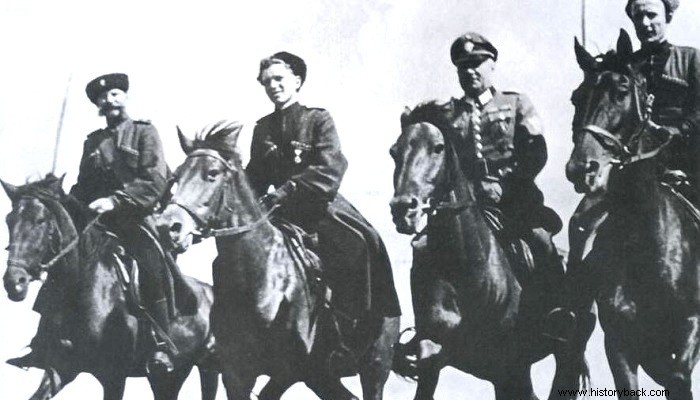
In the Russian land, for centuries, there were peoples who "produced" excellent light horsemen. The most famous were the Cossacks. They followed various Asian tribes, such as the Tatars or the Kalmuks. The Cossacks gradually joined the Russian, tsarist armies, from the 16th century and remained loyal until the Russian Civil War.
This fact had the consequence of falling out of favor with the new, Soviet regime. Fatefully when the Germans invaded the USSR many Cossacks sided with them. German units unplanned enlisted Cossack horsemen in their ranks.
In August 1941 an entire Red Army Cossack regiment defected to the Germans. This unit became the first, officially, German cavalry unit of the German Army. This unit was named 102 Kosacken Abteilung (102nd Cossack Division). It was later called the 600 Ost Abteilung and finally the 5th Don Cossack Regiment.
In April 1942 Hitler authorized the formal formation of Cossack regiments. At that time, four regiments were formed, the first two in the area of responsibility of Army Group (OS) "South" and the other two in the area of responsibility of OS "Center".
The XL Panzer Corps formed a detachment of Cossacks from prisoners. These Cossacks were trained and formed the 1st Company of the 82nd Cossack Regiment. They fought for the Germans until 1944, when they fell fighting in Normandy, in 1944.
In September 1942 Lieutenant Colonel Helmut von Panwitz proposed to his superiors the formation of a Cossack division. Panvic, a cavalry officer himself, had already commanded a unit of Cossacks fighting alongside the Romanian cavalry. His proposal was accepted and he undertook the formation and administration of the new division.
The division was officially formed in August 1943 and extended five Cossack regiments (Platov, von Jungensultz, Lehmann, Kononov and von Wolff). Other smaller units soon joined the division, but there were others that remained independent.
Eventually the Cossack Division was organized into two brigades, each with three regiments and a mounted artillery squadron. Each regiment had six islands. Each brigade also had a heavy howitzer with four 81mm mortars and four machine guns.
The division also had an anti-tank ulama with 50mm guns. Service units and divisions were formed accordingly. The light armament of the division was somewhat compensated by the large number of men at its disposal, as each regiment had about 2,000 men.
The Cossack Division was transferred to Croatia and acted against Tito's partisans. After that, it was decided to form a second division. The nucleus for its formation was the 2nd Brigade of the 1st Cossack Division.
At the end of 1944 it was decided to form a third division. The three divisions joined the XV SS Army Corps. The Cossacks fought against the Soviets when they arrived in Yugoslavia.
There the two most recently formed divisions were disbanded. The 1st, along with the remnants of the others retreated to Austria where they were finally surrendered to the British. But they were handed over to the Soviets, where the fate of the men was predetermined. In death he voluntarily followed his men and the lieutenant general, now von Panwitz.
Kalmuk cavalry units were formed in a similar way when the Germans reached the Kalmuk steppe, in the area of Elista. A total of 24 Kalmyk cavalry units were formed, which operated mainly against Soviet partisans.
They followed the Germans in retreat and eventually, in 1945, found themselves fighting in Poland and up to the gates of Berlin. The lucky ones among them were killed in the battles. The unfortunates were captured by the Soviets and met a horrible death.
